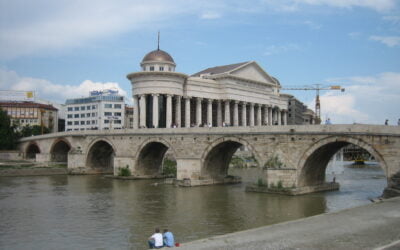Šarena Mosque
-
The city of Tetovo is home to the beautiful Sharena (coloured) Musjid located near the Pena River in North Macedonia. The Musjid was originally built in 1495 being financed by two sisters, and later rebuilt in 1833 by Abdurrahman Pasha. Unlike other Musjids of the Classical Ottoman period, the Šarena Musjid is more characteristic of traditional Musjids in Anatolia, as it was constructed before the conquest of Constantinople, when Byzantine-influenced Musjid domes became the standard design.
-
What makes the Tetovo Musjid so unique is its ornate wall paintings, which feature both inside and out. Created using a ‘secco’ technique, where pigments are combined with an organic binder – in this case eggs – and applied directly to dry plaster. It’s said that more than 30,000 eggs were used for the paint and glaze.
-
Inside, the Musjid is covered from dome to carpet with bright patterns. Floral, geometric and arabesque characters feature in the place of the usual Islamic motifs, and the dominant colours are earthy golds and reds. Curved lines, fleur-de-lis-like shapes, bouquets and grapevines are almost Austro-Hungarian in appearance.
-
The city of Tetovo is home to the beautiful Sharena (coloured) Masjid located near the Pena River in North Macedonia. The Musjid was originally built in 1495 being financed by two sisters, and later rebuilt in 1833 by Abdurrahman Pasha. Unlike other Musjids of the Classical Ottoman period, the Šarena Musjid is more characteristic of traditional Musjids in Anatolia, as it was constructed before the conquest of Constantinople, when Byzantine-influenced Musjid domes became the standard design.
-
What makes the Tetovo Musjid so unique is its ornate wall paintings, which feature both inside and out. Created using a ‘secco’ technique, where pigments are combined with an organic binder – in this case eggs – and applied directly to dry plaster. It’s said that more than 30,000 eggs were used for the paint and glaze.
-
Inside, the Musjid is covered from dome to carpet with bright patterns. Floral, geometric and arabesque characters feature in the place of the usual Islamic motifs, and the dominant colours are earthy golds and reds. Curved lines, fleur-de-lis-like shapes, bouquets and grapevines are almost Austro-Hungarian in appearance.

